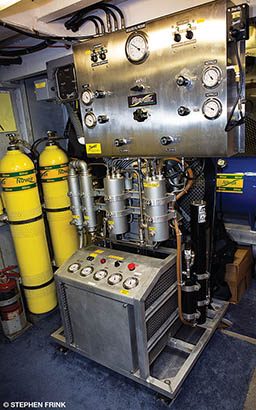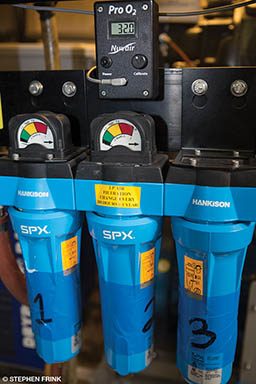One of the first things I tell students in compressor maintenance classes is this: “Providing breathing air for consumption in an increased partial-pressure environment is one of the most invasive things you can do to the human body.”
As most divers know, air is roughly 20.9 percent oxygen and 78 percent nitrogen. The remainder includes very small amounts of inert gases such as argon and carbon dioxide (CO2). The air we breathe on the surface also includes a small amount of water vapor. As the air is compressed, the water vapor is compressed into liquid water. Some oil mist (from oil-lubricated compressors) is produced as well, along with any gases or vapors that might have been drawn into the compressor intake. The water, oil and vapors are all considered contaminants and must be removed to provide the diver with clean, breathable compressed air. As the compressed air is breathed, the oxygen, nitrogen and any impurities travel from the alveoli in the lungs into the bloodstream and then to the body’s tissues and cells.
There are basically two types of compressors used for breathing air production: low pressure and high pressure. Examples of low-pressure units (approximately 140 psi to 250 psi) are hookah rigs and hard-hat systems. High-pressure units are used to compress air up to 6000 psi for filling scuba and storage cylinders.

The level of impurities in the final output of a compressor depends on the type of purification system used (if any) and how often the filters are changed.
Some recreational low-pressure compressors have little or no filtration included. Diving depths with these are restricted due to hose length and air production, but one must still be very careful about what is drawn into the intake, especially when it comes to carbon monoxide (CO). CO, a product of engine exhaust, is deadly and can be drawn into a compressor’s intake if the intake is placed too near a potential source of CO.
High-pressure compressors, on the other hand, have several stages that increase the pressure to levels that allow the air to be pressed into scuba cylinders and/or storage banks. Each stage compresses (and condenses) the air, so the air must be cooled and the moisture/oil mist captured, which is done with cooling coils and separators. The separators must be purged in a timely fashion — usually every 10-15 minutes, depending on the humidity. This is done manually with many smaller portable compressors but usually with an autodrain system on larger stationary units.
The final air delivery then needs to be purified via filtration. A typical purification filter will contain three substances: a drying agent, activated carbon (to remove remaining oil mist and odors) and a catalyst to convert CO into CO2. The media inside a purification filter has a useful limit, so proper filter changes must be conducted based on the amount of air that passes through it.
There are other gases produced for diving, the most common of which is nitrox. Nitrox (also known as enriched air or EANx) is any gas mix that contains an elevated percentage of oxygen between 23.5 percent and 39 percent. Nitrox can be produced by the following methods:

- Adding pure oxygen to a cylinder and topping it off with pure air is called partial-pressure blending. This procedure, like any process that requires handling pure oxygen, presents an increased risk of fire, equipment damage and serious injury or death and thus requires specialized training and oxygen-clean equipment.
- A nitrox stick mixes oxygen with air in the intake of the high-pressure compressor. This method also warrants caution since pure oxygen must be used. The oxygen is metered into the stick so that the end product produced is the targeted percentage.
- A membrane system moves low-pressure air through a membrane that pulls away nitrogen so that a mix that is higher in oxygen remains. This desired gas is delivered to the intake of the high-pressure compressor.
Regardless of the means of nitrox production, the creation of nitrox is best left to diving professionals for safety considerations. A nitrox course provides the information necessary for understanding what mix to use for diving at various depths.
To help ensure their air is safe, recreational divers can do the following:
- Prior to using a compressed-air cylinder, carefully open the valve slightly and check for any odors. If an odor is present, do not use the cylinder. An odor may indicate that the filtration system on the compressor that purified the air is either past due for servicing, has had a mechanical failure, has drawn in harmful vapors or has been contaminated by an autodrain system failure.
- If the cylinder is filled with nitrox, analyze the oxygen percentage prior to use to ensure that it is as expected. Cylinders containing gases other than air by law must be marked with the gas they contain.
- Consider using a CO sensor or analyzer. CO-Pro by Lawrence Factor, for example, is a quick, effective and affordable way to check for the presence of CO.
- Most important, find a high-pressure air source you can trust. Some states (such as Florida) require quarterly air testing. Ask the facility where you buy your air what preventative maintenance practices they follow. Most dive operations are proud of their air and nitrox systems and would be happy to show them off.
Compressing breathing air or nitrox into a scuba cylinder is hard work — for both the compressor and the technician operating the equipment. Vigilance and regular maintenance are required to ensure that the air produced is certifiable to the Compressed Gas Association’s Grade E standards for scuba. Play it safe by knowing your source so you can feel confident about the gases invading your body tissues.
© Alert Diver — Q4 Fall 2016